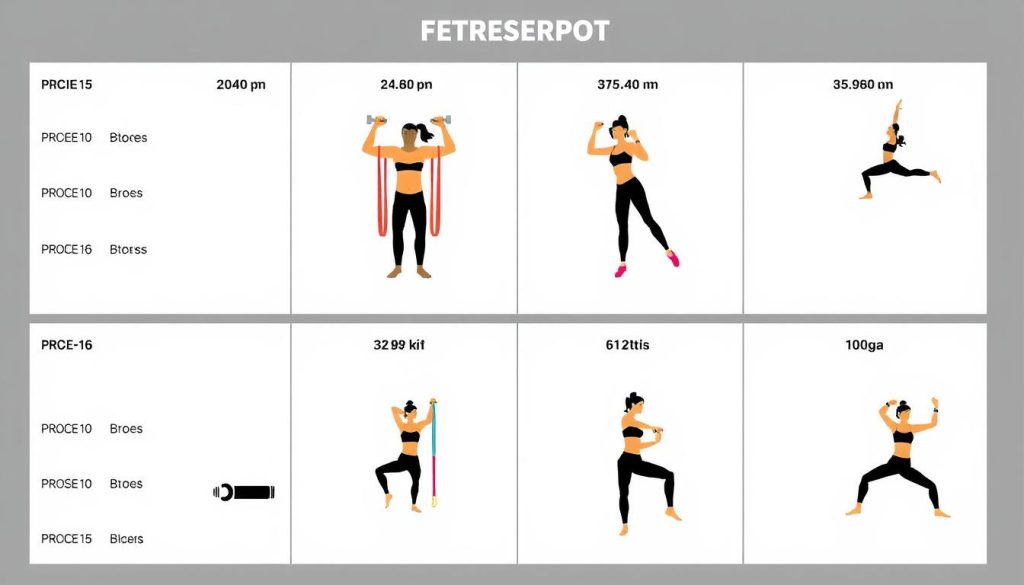Starting my fitness journey, I see how key exercise and fitness are for health. The Mayo Clinic says starting a fitness program is great for your health. It can lower disease risk and boost balance and coordination.
I want to share a detailed guide on getting fit. We’ll cover exercise basics, starting a workout, and advanced techniques for better results.
Regular exercise, like a routine with at least 150 minutes of moderate activity weekly, offers many health benefits. I’ll show how to make a fitness plan that fits your level, whether you’re new or experienced. Plus, I’ll share tips on staying motivated and tracking your progress.
With the right exercise and fitness approach, you can reach your goals and boost your health.
Key Takeaways
- At least 150 minutes of moderate aerobic activity weekly is recommended for health benefits
- Strength training exercises should target all major muscle groups at least two times per week
- A minimum of 30 to 60 minutes of exercise is recommended most days of the week as fitness improves
- Bodyweight exercises can provide a comprehensive workout without the need for any equipment
- Regular assessments of fitness progress should occur at six weeks into the program and then every few months thereafter
- Engaging in regular bodyweight training can lead to muscular improvements akin to those seen in resistance training
Understanding the Basics of Exercise
Regular physical activity is key for good health. The American Heart Association says you need at least 150 minutes of moderate aerobic activity or 75 minutes of vigorous aerobic activity each week. Doing training often can lower the risk of chronic diseases and boost your mental health.
To start a workout routine, knowing the different physical activity types is important. These include aerobic exercise, strength training, and flexibility exercises. The Guardian says finding a purpose and making exercise a habit can help you stay on track.
Different Types of Physical Activity
- Aerobic exercise, such as running or cycling
- Strength training, such as weightlifting or bodyweight exercises
- Flexibility exercises, such as yoga or stretching
Benefits of Regular Exercise
Regular exercise brings many health benefits. It can lower the risk of heart disease and certain cancers. It also boosts mental well-being and reduces chronic disease risk. The Department of Health and Human Services suggests at least 150 minutes of moderate aerobic activity weekly for adults.
Setting Realistic Fitness Goals
Setting achievable fitness goals is crucial for staying motivated and successful. A balanced routine that includes various physical activity types and rest is essential. This way, you can enhance your health and keep up with your training program.
| Type of Exercise | Recommended Duration |
|---|---|
| Aerobic Exercise | At least 150 minutes per week |
| Strength Training | At least 2 times per week |
| Flexibility Exercises | At least 2-3 times per week |
Getting Started: Essential Pre-workout Preparations
Before you hit the gym, make sure you’re ready. This means knowing your fitness level, planning your workout, and getting the right gear. The Mayo Clinic says it’s key to check your aerobic fitness, muscle strength, flexibility, and body shape before starting.
Design a workout plan that mixes aerobics and strength training. Aerobics, like running or cycling, boost heart health. Strength training, on the other hand, builds muscle and fitness. Choose exercises that match your goals and target specific muscles.
Don’t forget to warm up before working out. Start with light cardio, like jogging or jumping jacks, and dynamic stretches. This gets your muscles ready and helps avoid injuries.
Here are some tips for starting a workout routine:
- Set achievable fitness goals
- Make a workout plan that balances aerobics and strength training
- Warm up to prevent injuries and improve performance
- Get the right equipment, like good shoes or a yoga mat
The Perfect Warm-up Routine for Every Workout
Before I start my workout, I always warm up properly. The American Heart Association says warming up can prevent injuries and boost performance. This is key for strength training and cardio, which need lots of energy and effort.
A good warm-up should include dynamic stretches, mobility exercises, and getting your heart rate ready. Dynamic stretches move your joints, while mobility exercises boost blood flow and flexibility. Getting your heart rate up is also crucial for exercise.
Dynamic Stretching Techniques
Leg swings, arm circles, and hip rotations are great dynamic stretches. They increase blood flow and flexibility, preparing your muscles for the workout. For cardio, start with jogging or jumping jacks to raise your heart rate.
Mobility Exercises
Mobility exercises like lunges and leg swings improve flexibility and range of motion. They’re vital for strength training, preparing muscles for heavy lifting and bending. Adding these to your warm-up can lower injury risk and enhance performance.
Adding strength training and cardio to your routine boosts heart health and muscle mass. A proper warm-up ensures you get the most from your workout and keeps injuries at bay.
Cardio Training: Your Path to Better Endurance
Regular exercise is key to boosting your heart health. The Mayo Clinic suggests adults do at least 150 minutes of moderate activity or 75 minutes of vigorous activity weekly. You can do this through activities like running, cycling, or swimming.
Studies show cardio training boosts endurance and lowers disease risk. For instance, kids who exercise four times a week in physical education do better than those who exercise twice a week.
Some perks of cardio training include:
- Improved heart health
- Helps with weight management
- Boosts energy levels
Mixing different activities is important to avoid injury. Combine high-impact and weight-supported exercises. Also, slowly increase workout time by 10-20% to improve endurance safely.
Adding cardio to your exercise routine boosts your fitness and lowers disease risk. Start slow and gradually increase workout intensity and time for best results.
| Activity | Recommended Duration | Frequency |
|---|---|---|
| Cardio Training | 150 minutes/week | 3-5 times/week |
| High-Intensity Interval Training | 25-50 minutes | 1-2 times/week |
Strength Training Fundamentals
Strength training is key in any workout plan. The American Heart Association says to do it two times a week. It boosts muscle and bone health. The Guardian stresses the need for correct form and technique.
A well-structured workout targets major muscle groups. Aim for 30 to 60 minutes, two days a week. Choose four to six exercises for each muscle group. Do two to three sets of eight to 10 reps for each.
Strength training boosts health and fitness. The Department of Health and Human Services suggests 150 minutes of moderate aerobic activity weekly. Two or three 20- to 30-minute strength training sessions a week can significantly improve strength.
Strength training offers many benefits. It increases metabolism, improves balance, and strengthens bones. It also helps manage chronic conditions like arthritis and diabetes.
Basic Movement Patterns
Knowing basic movement patterns is vital for strength training. Exercises like squats, deadlifts, and bench press work multiple muscles. Proper form and technique prevent injuries and maximize benefits.
Creating Your Personal Exercise Schedule
To reach your fitness goals, making a personal exercise plan is key. The Mayo Clinic says a good plan keeps you motivated and on track. The Physical Activity Guidelines for Americans suggest at least 150 minutes of moderate aerobic exercise or 75 minutes of vigorous aerobic activity weekly.
Your schedule should mix cardio, strength training, and balance exercises. Begin with gentle workouts and slowly increase the intensity. Don’t forget to include rest days to avoid injuries and overtraining.
Here are some tips for a great exercise schedule:
- Start with 30 minutes of moderate-intensity exercise, three to four times a week.
- Do strength training exercises at least two times a week, covering all major muscle groups.
- Add balance exercises, like tai chi or yoga, to improve stability and reduce fall risks.
- Always schedule rest and recovery days for your body to heal and rebuild.
Consistency and patience are crucial for fitness success. A tailored exercise plan and sticking to it can boost your health and well-being. The Guardian advises finding a workout buddy and tracking your progress to stay motivated.

By following these tips and staying committed, you can hit your fitness goals. Regular physical activity brings many benefits, including better health and well-being.
Nutrition and Exercise: The Perfect Partnership
As I keep going on my fitness path, I’ve learned how key a balanced diet is with regular exercise. A healthy diet gives me the energy I need for my workouts. This could be a tough aerobics session or a gym session focused on strength training. The American Heart Association says eating lots of fruits, veggies, and whole grains is key for good health.
It’s important to think about when I eat before working out. Big meals should be eaten 3 to 4 hours before, and small ones 1 to 3 hours before. For example, if I have a morning aerobics class, I eat a light breakfast an hour before. This gives me energy without feeling too full. Also, drinking 2 to 3 cups of water 2 to 3 hours before is crucial.
For post-workout nutrition, I aim to eat a meal with carbs and protein within two hours. This helps my muscles recover and my glycogen levels get back to normal. Some good meals include:
- Grilled chicken with brown rice and steamed veggies
- Whole grain pasta with lean beef and marinara sauce
- Salmon with quinoa and roasted sweet potatoes
These meals have complex carbs, lean protein, and healthy fats. They help me reach my fitness goals. By focusing on nutrition and exercise, I get the most out of my workouts and stay healthy.
Common Exercise Mistakes to Avoid
When you do strength training and cardio, knowing common mistakes is key. These mistakes can slow your progress and raise injury risks. It’s vital to use the right form and technique to avoid injuries.
Some common errors include lifting too much weight, not adjusting machine settings, and not keeping the spine straight during deadlifts. Many people also do squats wrong, with their knees not in line. And, they often strain their necks during pull-ups.
To steer clear of these errors, focus on the right form and technique. Start with lighter weights and slowly add more. This approach helps you avoid injuries and get the most out of your workouts.
- Start with lighter weights and gradually increase them.
- Regularly do strength training and cardio exercises.
- Listen to your body and rest when needed.
By being aware of these common mistakes and avoiding them, you can have a safe and effective workout. This workout should include both strength training and cardio exercises.
| Mistake | Percentage of Individuals Affected |
|---|---|
| Improper squat form | 70-80% |
| Failure to maintain neutral spine during deadlifts | 45% |
| Straining neck during pull-up exercises | 60% |
Measuring Your Progress and Making Adjustments
Tracking my progress is key to reaching my fitness goals. The American Heart Association agrees. I’ve learned that measuring my fitness and adjusting my routine keeps me motivated.
I set realistic goals, like losing weight or getting stronger. For example, I aim to lose 1.67 pounds a week to reach my 20-pound goal in three months. I also track my workouts, noting the exercises, weights, and reps. This helps me see where I need to improve.
Finding a workout buddy is also important. The Guardian says it keeps you motivated. Having someone to share progress with makes a big difference. ![]()
Here are some ways I track my progress:
- Tracking my body measurements, like waist circumference and body fat percentage
- Celebrating non-scale victories, like better energy or sleep
- Regularly checking my fitness plan to see what works and what doesn’t
- Using fitness apps to log my workouts and get insights
These strategies help me track my progress and stay motivated. Remember, tracking progress is key to achieving your fitness goals. With hard work and dedication, you can reach your goals and live a healthy, active life.
Advanced Training Techniques for Better Results
I’ve been working on my workout routine and found some advanced techniques. The Mayo Clinic says high-intensity interval training boosts performance and muscle. The Guardian agrees, saying these methods improve health and fitness.
I’ve tried high-intensity interval training, which mixes intense exercise with rest. Supersets and circuit training also work well, targeting many muscles and keeping workouts fun. Progressive overload methods help me keep pushing and seeing results.
There are many ways to add these techniques to your routine. For instance, you can:
- Use high-intensity interval training to boost heart health and burn fat
- Try supersets and circuit training to strengthen more muscles at once
- Apply progressive overload to keep challenging yourself and seeing progress
By using these advanced techniques, you can enhance your workout and see better results. They’re great for improving health, fitness, or just for a new challenge. These methods keep me motivated and help me reach my goals.
Staying Motivated Through Challenges
As I keep going on my fitness journey, I’ve learned that staying motivated is key. The American Heart Association says finding a workout buddy and tracking progress helps a lot. Exercise should be a habit, and making it daily has changed the game for me.
Studies show tracking progress boosts motivation by about 33%. Working out with a partner can make you more consistent by 60%. I set specific, achievable goals and have seen big improvements in my health and well-being.
Here are some strategies that help me stay motivated:
- Setting realistic goals and tracking progress
- Working out with a partner or joining a fitness class
- Incorporating variety in my training routine to avoid plateaus
- Rewarding myself for reaching milestones
| Strategy | Effectiveness |
|---|---|
| Setting specific goals | 50% more likely to achieve fitness goals |
| Tracking progress | 33% improvement in motivation levels |
| Working out with a partner | 60% more likely to be consistent with exercise routines |
By using these strategies, I’ve stayed motivated and focused on my goals. Remember, training and health are connected. Finding a balance that works for you is key to success.
Conclusion: Your Journey to Fitness Success
Looking back, creating a workout plan that fits you is crucial. The Mayo Clinic says it’s important to make a routine that works for you. The Guardian agrees, saying finding a purpose and sticking to it helps keep you going, even when things get tough.
We’ve talked about the benefits of different exercises like gym, aerobics, strength training, and cardio. These activities not only boost your fitness but also your energy and mood. Aim for 4-6 workouts a week to see real changes.
Keep yourself motivated by setting clear goals and tracking your progress. Surround yourself with people who support you. With hard work and a smart plan, you’ll reach your fitness goals. Here’s to your health and happiness – may this guide help you on your journey.


